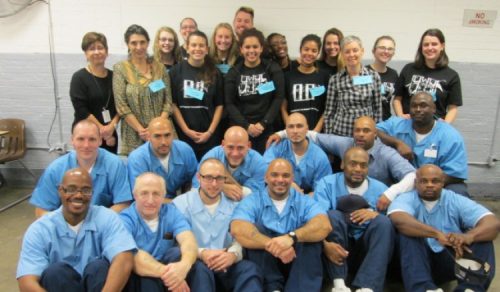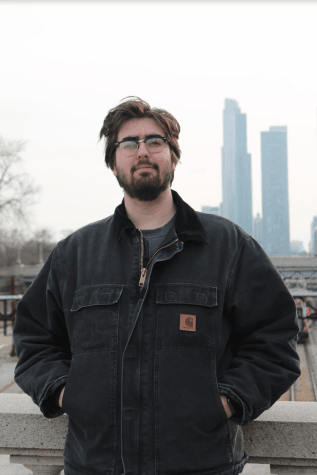Friday morning classes can sometimes feel like prison – especially when the class is inside of a maximum-security penitentiary.
Students who chose to participate in DePaul’s Inside-Out Prison Exchange Program take classes alongside inmates at the Cook County Jail, the largest jail in the U.S., and the Stateville Correctional Center, a maximum-security men’s prison near Joliet, Illinois. Stateville is famous for holding serial killer Richard Speck and being the execution site of John Wayne Gacy, who was convicted of raping and murdering 33 young men.
DePaul started teaching at Stateville in 2011 and at Cook County Jail in 2014. The program began with just one class but has now expanded to four classes. DePaul currently offers classes on Restorative Justice, Law, Politics and Mass Incarceration, Theater Studies and a Masculinity, Gender and Law course.
Christina Rivers, one of the teachers at the prison, said the Inside-Out program is important to DePaul’s culture because it perfectly echoes the Vincentian mission.
“Our patron saint, St. Vincent DePaul fought for the benefit of those who would have been otherwise ignored, excluded or reviled,” Rivers said. “Prisoners are all three. I can’t think of any program we have (at DePaul) – and we have a lot – that fits the Vincentian mission better than the Inside-Out Program.”

(photo courtesy of Illinois Department of Corrections)
But the program does more than just echo the Vincentian Mission – it is an exact continuation of St. Vincent DePaul’s service from 500 years ago.
“I actually found out from (former DePaul president) Rev. Holtschneider that St. DePaul used to minister to prisoners who were forced to work on the trading ships,” Rivers said.
The check-in process is not a run-of-the-mill roll call. Students and teachers are all required to wear baggy sweatpants and matching baggy t-shirts. Alex Boutros, a teacher’s assistant for the Restorative Justice class at Stateville, said they are checked thoroughly several times over by correctional officers before proceeding through six layers of security to the prison schoolrooms.
“All the women have to shake out their bras in front of the correctional officers to show we’re not bringing anything in that we’re not supposed to,” Boutros said. “Everybody is required to wear underwear, and sometimes the guards check to make sure we are.”
Professor Laura Biagi, the driving force behind the implementation of a theater course for the Inside-Out Program, agreed with the sentiment that the program is necessary at DePaul because of the university’s tradition of upholding the Vincentian mission.
“At the core of the mission is applying your education to improving the world,” Biagi said. “The education students receive at DePaul is a tool for social change, it’s not something you acquire. It’s transformative and a beautiful expansion of your mind.”
Biagi stated the importance of having DePaul’s theater students participate in the Inside-Out Program because it diversifies their skill sets in a competitive field while simultaneously being a force for good.
“Theater is a very challenging field. It’s very competitive, it’s based on image and beauty,” Biagi said. “To know that theater can be brought into jails is healthy for students because it’s a safety net (if they don’t make it in the theater industry). Then they are already well-equipped to bring these skills to marginalized communities.”
Students in Biagi’s class sit in a circle, one inmate next to one DePaul student. The classes are not just about teaching the material, but about teaching the students about the inmates and the inmates about the students.
“What we’re doing is fostering the creation of a community,” Biagi said. “We have icebreaking exercises that are aimed to teach everybody not about their differences, but about the similarities they have to one another.”
Boutros said the opportunity to do good for these people, some of whom are serving life sentences for violent crimes, is a blessing.
“All of these guys have grown up their whole lives constantly being told that they’re worthless,” Boutros said. “A lot of them are broken. When they hear any kind of verbal abuse, they break down. (The Inside-Out Program) gives so many of them so much more to think about. Doing this program is like telling them for the first time that they are worth something. They have never heard that before.”
Despite being in close quarters with men convicted of violent crimes, Boutros said she has never once been put in a situation where the inmates made her fear for her safety. Rather, it is those who are tasked with protecting them that have created the most problems for the group.
“They hear our laughter and our joy and they see that as something they need to keep an eye on,” Boutros said. “They clearly see the inmates as prisoners first and people second. They are incredibly institutionalized, I would argue that they are more behind bars than the guys inside are.”
The program is not merely a philanthropic endeavor solely for the benefit of the inmates. Those involved say it is a two-way street. Both the inmates and the students learn not only from the class, but from each other.
“The program forces us to break down barriers and misconceptions that we have about people who are incarcerated,” Rivers said. “But it also forces them to break down those same barriers and misconceptions that the inmates have about us.”
“Every single student that goes in (to the prison) gains a new perspective that they couldn’t get anywhere else,” Boutros said. “Every day we work with people that they would pass on the street and be afraid of.”





